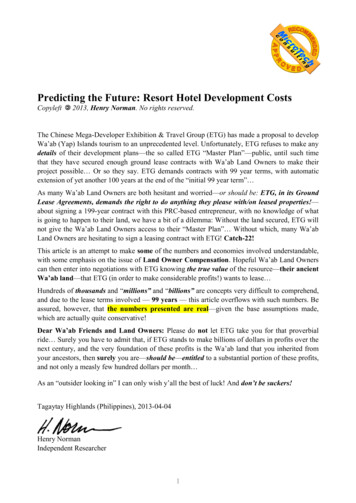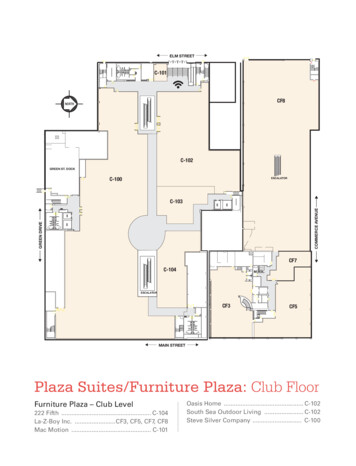
Transcription
PLAZA HOTEL INTERIORDesignation ReportNew York City Landmarks Preservation CommissionJuly 12, 2005Designation List 366LP-2174
PLAZA HOTEL INTERIOR: TABLE OF CONTENTSSite DescriptionTestimony at Public Hearing22EssaySummaryFifth Avenue and the SiteConstruction and Opening of Plaza HotelHotel ArchitectureFrederic SterryHenry Janeway HardenberghWarren & WetmoreThe 1905-07 Design of the Plaza Hotel’s Interiors1919-1922 addition and 1929 Grand BallroomThe Hilton Plaza (1943-1953)Plaza Hotel (1953 to present)Plaza Hotel Social HistorySite Plans344566781113141421Individual Room EntriesThe Edwardian Room59th Street LobbyFifth Avenue Lobby and VestibulesGrand BallroomCorridor and FoyerMain CorridorsThe Oak BarThe Oak RoomThe Palm CourtTerrace RoomCorridor, FoyerStairwaysFindings and DesignationReport researched and written by Research DepartmentMary Beth Betts, Director of Research, Michael Caratzas, Gale Harris,Virginia Kurshan, Matthew A. Postal, Donald Presa, and Jay ShockleyAll photos by Carl Forster24293135444952576272
PLAZA HOTEL INTERIORPlaza Hotel, ground floor interior consisting of the Fifth Avenue vestibules, Lobby, corridor tothe east of the Palm Court, the Palm Court, Terrace Room, corridor to the north of the Palm Courtconnecting to the 59th Street Lobby and the Oak Room, foyers to the Edwardian Room from thecorridor to the north of the Palm Court and the 59th Street Lobby, the Edwardian Room, 59thStreet Lobby and vestibule, the Oak Room and the Oak Bar, corridor to the east of the OakRoom, corridor to the south of the Palm Court, and the staircases connecting the ground floor tothe mezzanine floor; mezzanine floor interior consisting of the Terrace Room Corridor,Mezzanine Foyer, Terrace Room balcony, Terrace Room and fountain, and the staircaseconnecting the mezzanine floor to the first floor Grand Ballroom Foyer; first floor interiorconsisting of the Grand Ballroom Foyer, Grand Ballroom Corridor, Grand Ballroom and stage,and Grand Ballroom boxes; and the fixtures and the interior components of these spaces,including but not limited to, wall surfaces, ceiling surfaces and floor surfaces, murals, mirrors,chandeliers, all lighting fixtures, attached furnishings, doors, exterior elevator doors and grilles,railings and balustrades, decorative metalwork and attached decorative elements; 768 FifthAvenue and 2 Central Park South, Borough of Manhattan. Built 1905-07; 1919-22; 1929;architects Henry Janeway Hardenbergh, Warren & Wetmore, and Schultze & Weaver.Landmark Site: Borough of Manhattan Tax Map Block 1274, Lot 25.On June 7, 2005, the Landmarks Preservation Commission held a public hearing on theproposed designation as an Interior Landmark of the Plaza Hotel, ground floor interior consistingof the Fifth Avenue vestibules, Lobby, corridor to the east of the Palm Court, the Palm Court,Terrace Room, corridor to the north of the Palm Court connecting to the 59th Street Lobby and theOak Room, foyers to the Edwardian Room from the corridor to the north of the Palm Court andthe 59th Street Lobby, the Edwardian Room, 59th Street Lobby and vestibule, the Oak Room andthe Oak Bar, corridor to the east of the Oak Room, corridor to the south of the Palm Court, andthe staircases connecting the ground floor to the mezzanine floor; mezzanine floor interiorconsisting of the Terrace Room Corridor, Mezzanine Foyer, Terrace Room balcony, TerraceRoom and fountain, and the staircase connecting the mezzanine floor to the first floor GrandBallroom Foyer; first floor interior consisting of the Grand Ballroom Foyer, Grand BallroomCorridor, Grand Ballroom and stage, and Grand Ballroom boxes; and the fixtures and the interiorcomponents of these spaces, including but not limited to, wall surfaces, ceiling surfaces and floorsurfaces, murals, mirrors, chandeliers, all lighting fixtures, attached furnishings, doors, exteriorelevator doors and grilles, railings and balustrades, decorative metalwork and attached decorativeelements; and the proposed designation of the related Landmark Site (Item No. 2). The hearingwas continued to June 28, 2005 (Item No. 1). Both hearings had been duly advertised inaccordance with the provisions of law. Twenty-two people spoke in favor of designation,including the owner, State Assembly Member Richard N. Gottfried, the Chairman of theLandmarks Committee of Community Board 5 and representatives of the New York Chapter ofthe American Institute of Architects, the Landmarks Conservancy, the Preservation Committee ofthe Municipal Art Society, Historic Districts Council, the Beaux Arts Alliance, Friends of theUpper East Side, the Metropolitan Chapter of the Victorian Society in America, Society for theArchitecture of the City, East 85th – East 86th Streets Park to Lexington Avenue BlockAssociation, Landmark West!, Defenders of the Historic Upper East Side, Place Matters, the RealEstate Board of New York, and the New York Hotel and Motel Trades Council. Several peoplerequested that the designation include additional rooms. In addition the Commission has receivedhundreds of communications in support of designation, including letters from the NortheastOffice of the National Trust for Historic Preservation, the Preservation League of New YorkState, the Women’s City Club of New York, several architects and architectural historians, andmembers of the 4th grade class of Cider Mill School, Wilton, Connecticut.
SummaryThe Plaza Hotel, one of the world's great hotels since it opened in 1907, is located on aprominent site overlooking Central Park, Grand Army Plaza and Fifth Avenue. In 1971 The NewYork Times architecture critic, Ada Louise Huxtable, called it "New York's most celebratedsymbol of cosmopolitan and turn-of-the-century splendor, inside and out."1 The exterior has beena beloved designated New York City Landmark since 1969. The eight major publicly accessiblerooms as well as the adjacent corridors, vestibules, stairways and foyers are largely a result offour different campaigns: Henry Hardenbergh's original design of 1905-07; the 1919-1921renovation and addition by Warren & Wetmore; Schultze & Weaver’s ballroom from 1929; andConrad Hilton's renovation of the building when he acquired it in 1943. Hardenbergh, Warren &Wetmore and Schultze & Weaver were three significant early twentieth-century Americanarchitectural firms which were pre-eminent hotel designers. The Plaza Hotel is one of HenryHardenbergh’s most famous and critically acclaimed buildings. Hardenbergh set standards forthe design of luxury American hotels on the exterior and interior of his buildings. The Plaza Hotelinteriors are rare surviving examples of Hardenbergh’s interior designs in New York City andrepresent his spatially sophisticated planning and mastery of historical revival styles. The BeauxArts style 59th Street Lobby and Main Corridor feature strikingly veined and carefully matchedstonework in white and Breccia marble. The German Renaissance Revival style Oak Roomfeatures wood paneling with elaborate carvings on the west wall, murals of medieval castles and acoved plaster ceiling. The Spanish Renaissance Revival style Edwardian Room features a paneledwood wainscoting and an elaborate trussed ceiling with carved bosses, stenciled decorations andmirrors. The neo-Classical style Palm Court features walls faced with Caen stone and accentedwith a giant order of highly polished marble pilasters, a colonnade of marble columns separatingthe space from the main corridor and marble caryatids representing the Four Seasons on the westwall. The 1921 addition by Warren & Wetmore includes the neo-Classical style Fifth AvenueLobby and neo-Renaissance style Terrace Room. The firm was known for its hotel interiors,which accommodated the expanding social demands of well-to-do Americans by providing vasthalls for promenading, lounging and public dining. The Terrace Room features painteddecorations by noted interior decorator John Smeraldi, and different levels of space, while itsfoyer features pilasters with ornate capitals and a richly decorated coffered ceiling. These spacesare rare extant examples in New York City of Warren & Wetmore’s hotel interiors. Schultze &Weaver’s 1929 Grand Ballroom represents the work of one of America’s significant hoteldesigners and its mastery of revival styles. The neo-Classical style room features attached Ioniccolumns and an elaborate coved ceiling. The Plaza Operating Company owned the currentbuilding and its predecessor from 1902 to 1943 and the Plaza was managed by noted hotelierFrederic Sterry from 1905 to 1932. In 1943 the hotel was acquired by the Atlas Corporation,which was affiliated with famed hotelier Conrad Hilton, who owned the building until 1953.Hilton opened the Tudor Revival style Oak Bar and commissioned Everett Shinn to paint threemurals specifically for the space in 1945. The hotel’s current owner acquired the property inAugust 2004. From its opening in 1907 the Plaza Hotel’s public spaces have been used by itsguests as well as the general public including the thousands of people who took tea at the PalmCourt and habitués, such as George Cohan, of the Oak Room. The Terrace Room has been usedfor receptions and press conferences including that of Marilyn Monroe and Laurence Olivier. TheGrand Ballroom has been the site of benefits, weddings and dances, most notably TrumanCapote’s 1966 Black and White Ball. In 1975 The New York Times, in an editorial calling for thedesignation of the Plaza’s publicly accessible spaces, described the interiors as “among the mostsplendid public spaces in the city.”2
Fifth Avenue and the Site3For most of the nineteenth century, successive portions of Fifth Avenue enjoyed thereputation of being New York’s most prestigious residential street. As the Avenue wasdeveloped northward from Washington Square, its character reflected the growth and change ofManhattan with newer, northerly, residential sections followed closely by commercialredevelopment. After the Civil War, Fifth Avenue between 42nd and 59th Streets was built upwith town houses and mansions for New York’s elite, yet by the turn of the century profoundcommercial change had occurred. One writer in 1907 commented that “among the many radicalchanges which have been brought about during the past six years in New York City, the mostradical and the most significant are those which have taken place on Fifth Avenue. Thatthoroughfare has been completely transformed.”4 Fifth Avenue became an elegant boulevard ofprestigious retail shops, department stores, luxury hotels, and elite social clubs, as well as thecenter of American fashion. In the vicinity of the Plaza Hotel are the St. Regis Hotel (1901-04,Trowbridge & Livingston; 1927, Sloan & Robertson), 699-703 Fifth Avenue; University Club(1896-1900, McKim, Mead & White), 1 West 54th Street; and Gotham Hotel (1902-05, Hiss &Weekes), 696-700 Fifth Avenue (all designated New York City Landmarks).The City of New York subdivided the land that is now the Plaza Hotel site into lots andbegan selling them off in 1853.5 The parcels were transferred several times before a JohnAnderson purchased and slowly assembled the site between 1870 and 1881.6 Accounts differ asto what occupied the Plaza site, some situate the 5th Avenue Pond, site of the New York SkatingClub, on the Plaza site, while an 1879 aerial perspective shows the land as vacant.7 According tothe Real Estate Record and Guide the first serious attempt to improve the property occurred in1882, when Jared Flagg headed a syndicate of investors planning to build a twelve-storyapartment house laid out by his son, architect Ernest Flagg, with exteriors designed by architectWilliam Potter.8 Flagg’s plans did not materialize and, in 1883, the property was acquired byJames Campbell and John Duncan Phyfe who hired architect Carl Pfeiffer to design a nine-storyapartment hotel.9 Construction began in 1883, but it is not known how much of the building wasconstructed.10 In 1888, the New York Life Insurance Company acquired the property and hiredMcKim, Mead & White to substantially alter and complete the building as a hotel. The eightstory tall building was a brick and brownstone Renaissance-Revival style structure.11 Thebuilding featured an up-to-date ventilation system and electrical plant and had luxuriouslydecorated public rooms. The 1893 King’s Handbook of New York described the new building as“one of the most attractive public houses in the wide world,” and praised its location in one of thecity’s most “aristocratic” neighborhoods and across from a main entrance to Central Park.12Construction and Opening of the Plaza Hotel13During the 1890s the Plaza Hotel was a fashionable but remote address; by 1900 it was apivotal location linking the shopping district of Fifth Avenue, the well-to-do residentialneighborhood of the Upper East Side and the pleasures of Central Park. Bernhard Beinecke, aformer meat wholesaler with connections to the hotel industry, and Harry S. Black, of the FullerConstruction Corporation and United States Realty and Construction Corporation, realized thesite’s potential and purchased it in 1902.14 Beinecke and Black examined a number of options forthe site, including adding to the older building. Its foundations, however, would not support anyadditional stories. The two started to plan for a new building, but lacking the necessary financing,Beinecke and Black approached John Gates, one of the wealthiest men in the United States whohad made his fortune on barbed wire patents. He agreed to back the project with one stipulation,that Fred Sterry be hired as the hotel’s managing director. Demolition of the old hotelcommenced in June 1905 and two months later the site was cleared and construction had startedon the new building.15 Originally planned to cost 8,500,000, the hotel ultimately cost 12,500,000 to construct and furnish.16 The new Plaza Hotel officially opened on October 1,1907, with Alfred Gwynne Vanderbilt the first guest to sign the register.17 The hotel’s
management intended the 753 rooms to be used by 550 guests, of which over half would bepermanent, and included Gates, Vanderbilt, George J. Gould and Col. William Jay.18Hotel Architecture19Hotels have played an important role in the life of the city since the earliest taverns andinns of New Amsterdam dispensed food, drink, lodging and entertainment to colonial travelers.For many years the Astor House, built in 1836 by Isaiah Rogers, on Broadway between Barclayand Vesey Street, provided the utmost in comfort and convenience to its guests. Not only was thebuilding large, but it was equipped with the latest facilities, including a bath and toilet on everyfloor. As the population moved northward, so did the hotel district. By 1859, the Fifth AvenueHotel, called the “first modern New York Hotel,”20 opened on Madison Square, offering itspatrons amenities such as New York’s first passenger elevator and luxuriously decoratedinteriors. As the nineteenth century progressed, hotels competed in size and grandeur. Perhapsthe ultimate in nineteenth-century hotel splendor was exemplified by the Waldorf and the AstoriaHotels (which functioned as one hotel and was designed by Henry J. Hardenbergh, 1893 and1897, demolished), which had 1,300 bedrooms and 40 public rooms, all lavishly and individuallydecorated.The Waldorf and Astoria complex was perhaps the largest, but it was certainly not uniqueamong the grand hotels of the late nineteenth century. Fostered by economic prosperity, the largeluxury hotels of this period became the venue for public life, supplying halls for promenading,dining rooms to be seen in, and private rooms in which to entertain and be entertained.21Improvements in transportation during the late nineteenth century made travel between andwithin cities easier, and people became more mobile, traveling for pleasure as well as business. Inaddition, hotels enhanced their sense of luxury by offering the latest technological advancements,including electricity, elevators, telephones, and central heat. By the turn of the century it wasobserved that hotels tended to “include within the walls of the building all the possible comfortsof modern life, facilities which formerly could be found only outside of the hotel walls.Telephones, Turkish baths, private nurses, physicians ”22 in addition to laundry, the services ofmaids and valets, barbers, and shoe shine boys. A huge staff was required to supply all theseservices, and this in turn, necessitated a huge building to make the whole enterprise financiallysound.23 Many hotel guests were in residence for lengthy periods of time, preferring not to besaddled with the responsibility of maintaining a large private home or being visitors who came toNew York City on an annual basis for a lengthy stay.The Waldorf and Astoria Hotels proved to be exemplars of hotel design on the exterior aswell. Not only did Hardenbergh follow his own design precedents in his later, influential hoteldesigns, but other architects (such as Clinton & Russell in the Hotel Astor) did as well. A. C.David, writing in 1905, proclaimed that the new, large hotels which were appearing in most citiesin the United States were “in a different class architecturally from any similar buildings whichhave preceded them.” This new type was large, tall (i.e. built with steel-frame construction), butnonetheless was created “in such a manner that it would be distinguished from the office-buildingand suggest some relation to domestic life.”24The St. Regis Hotel (1901-04, Trowbridge & Livingston) continued the technologicalinnovations of the Waldorf and Astoria Hotels but provided a more exclusive and refinedenvironment. Built out of limestone, employing a tripartite design and the Beaux-Arts style, theSt. Regis echoed the pale color and classical style of Fifth Avenue’s private residences. Incontrast to the Waldorf and Astoria, which “provides exclusiveness for the masses,” the St. Regissought “the patronage of people who were rich, and who were or wanted to be fashionable, butwhich also would be somewhat quieter and more exclusive.”25 The Plaza Hotel combined thetwo traditions appearing to blend in with the color and style of its neighboring Fifth Avenuemansions, but providing public spaces that immensely popular.
World War I and an economic recession in the early 1920s limited new building activityin New York City for several years.26 Stylistically, this was a transitional period, with theBuilding Zone Regulation of 1916 requiring setbacks that resulted in simplified, geometricallymassed buildings. Architects still clad these buildings with traditional, historically inspiredmotifs but simplified the decorative elements and stretched the spaces between them. New YorkCity hotels took on even greater social significance in the late 1910s and early 1920s due to thedifficulty of retaining the numerous servants needed to make a grand household function, and theclosing of large-scale restaurant complexes such as Delmonico’s and Rector’s. The 1920prohibition on alcoholic beverages, however, had a major impact on hotel economics and somehotel public spaces. H. I. Brock wrote: “the life of the lobby—the public rooms for dining andmeeting people—ceased. . . Conviviality was not extinguished, but it was compressed.”27Frederic Sterry (1866-1933)28Called one of the most “celebrated hoteliers” in the country, Frederic (Fred) Sterry wasborn in 1866 in Lansingburg, New York. His career in the hotel business began at the UnitedStates Hotel in Saratoga Springs, New York. His next position was the manager of the LakewoodHotel in Lakewood, New Jersey, and by 1893 Sterry was the managing director of the HomesteadHotel in Hot Springs, Virginia. According to The New York Times it was due to Sterry’s “able andtactful direction, his skillful handling of its special problems,” that the Homestead attractedwealthy visitors from throughout the United States and Europe. At the Homestead, Sterryattracted the attention of Henry M. Flagler, who persuaded Sterry, in 1895, to also manage theRoyal Ponciana and Breakers Hotels, both in Palm Beach, Florida. The managing director filled acritical role in early twentieth-century American hotels, Architectural Record noted: “Indesigning a hotel the manager, who as a rule obtains a long lease on the premises, becomes, forthe architect the real client, although he may not have any real ownership in the building. It is hewho is to make the investment profitable for the owner or owners, and who must thereforeexercise almost dictatorial power. . .to secure the most suitable and economic conditions for theoperation.”29 Sterry selected most of the furniture, linens, and tableware for the Plaza (whichincluded buying trips to Europe), handled the publicity, supervised a staff of hundreds, dealt withguests and planned important entertainments at the hotel.30 Sterry managed the Plaza from thetime of its opening until 1932, when he was forced to take a leave of absence due to ill health.Sterry was associated with many leading hotels. He continued to manage the Palm Beach hotelsas well as the Savoy-Plaza across the street from the Plaza in New York City, the Copley Plaza inBoston and the National Hotel in Havana, Cuba. He also consulted on the management of theGreenbrier Hotel in White Sulphur Springs, West Virginia.Henry Janeway Hardenbergh (1847-1918)31Born in New Brunswick, New Jersey, of Dutch lineage, Henry Janeway Hardenberghattended the Hasbrouck Institute in Jersey City, and received architectural training from theBeaux-Arts trained Detlef Lienau in 1865-70. Hardenbergh, who began his own architecturalpractice in New York in 1870, became one of the city’s most distinguished architects. Recognizedfor their picturesque compositions and practical planning, his buidings often took their inspirationfrom the French, Dutch, and German Renaissance styles. Hardenbergh was a prolific architectand designed many types of buildings, including: office buildings such as the Western UnionTelegraph Company Building (1884, located in the Ladies Mile Historic District) at Fifth Avenueand 23rd Street; the Astor Building (1885, demolished) on Wall Street; Romanesque Revival stylecommercial buildings such as the warehouse at Broadway and West 51st Street (1892,demolished) and the Schermerhorn Building (1889-90, a designated New York City Landmarkand located in the Noho Historic District), 376-380 Lafayette Street; as well as numerousindividual houses, both freestanding country homes and city rowhouses. Of the latter type, some
of his best-known eamples include the picturesque rows on West 73rd Street (in the Upper WestSide/Central Park West Historic District), built in 1882 for Edward S. Clark.Hardenbergh is best known, however, for his luxury hotel and apartment house designs.Among the earliest of these are the German Renaissance Revival style Dakota Apartments (188084, a designated New York City Landmark and located within the Upper West Side/ Central ParkWest Historic District), 1 West 72nd Street; and the Hotel Albert, now Albert Apartments (1883),75-77 University Place, aka 42 East 11th Street. His three earliest mid-town hotels, the Waldorf(1893-95), Fifth Avenue and West 33rd Street; its addition, the Astoria (1895-97), Fifth Avenueand West 34th Street; and the Manhattan Hotel (1896), Madison and East 42nd Street, have allbeen demolished, but when constructed they set the standard for luxury hotel design, both on theexterior and the interior. The turrets, gables and balconies seen on the exteriors formed apicturesque composition, while the comfortable interior arrangements, and fine decoration addedto the sumptuousness of the visitor’s experience. Hardenbergh continued to perfect his luxuryhotel designs in the Raleigh Hotel, Washington, D.C. (1898/1905/1911, demolished) and theWillard Hotel, Washington, D.C. (1900-01), as well as the Hotel Windsor (1906, with BradfordLee Gilbert) in Montreal, and the Copley Plaza Hotel (1910-12) in Boston. The Plaza Hotel isamong Hardenbergh’s most famous and critically acclaimed designs.Warren & Wetmore32Whitney Warren (1864-1943), born in New York City, studied architectural drawingprivately, attended Columbia College for a time, and continued his studies at the Ecole desBeaux-Arts in Paris from 1885 to 1894. Upon his return to New York, he worked in the office ofMcKim, Mead & White. One of Warren’s country house clients was Charles Delavan Wetmore.Born in Elmira, New York, Wetmore (1866-1941) was a graduate of Harvard University (1889)and Harvard Law School (1892), who had also studied architecture and had designed threedormitory buildings (c.1890) before joining a law firm. Impressed by his client’s architecturalability, Warren persuaded Wetmore to leave law and to establish Warren & Wetmore in 1898.While Warren was the principal designer of the firm and used his social connections to provide itwith clients, Wetmore became the legal and financial specialist.Warren & Wetmore became a highly successful and prolific architectural firm, bestknown for its designs for hotels and buildings commissioned by railroad companies. The firm’swork was concentrated in New York during the first three decades of the twentieth century, but italso executed projects across the United States and overseas. The designs were mainly variationsof the neo-Classical idiom, including essays in the Beaux-Arts and neo-Renaissance styles.Warren & Wetmore’s first major commission, the result of a competition, was the flamboyantNew York Yacht Club (1899-1900, a designated New York City Landmark), 37 West 44th Street.The firm was responsible for the design of the Chelsea Piers (1902-10, demolished), along theHudson River between Little West 12th Street and West 23rd Streets); the Vanderbilt Hotel (191013), 4 Park Avenue; and a number of luxury apartment houses, such as 903 Park Avenue (1912).Warren & Wetmore is most notably associated with the design of Grand CentralTerminal (1903-13 with Reed & Stem and William J. Wilgus, engineer, a designated exterior andinterior New York City Landmark), East 42nd Street and Park Avenue, as well as a number ofother projects in its vicinity. Whitney Warren was the cousin of William K. Vanderbilt, chairmanof the board of the New York Central Railroad, who was responsible for the firm’s selection aschief designers. Nearby development by the firm over the span of two decades included: HotelBelmont (1905-06, demolished); Biltmore Hotel (1912-14, significantly altered), VanderbiltAvenue and East 43rd Street; Commodore Hotel (1916-19, significantly altered), 125 East 42ndStreet; Hotel Ambassador (1921, demolished); and New York Central Building (1927-29, adesignated New York City Landmark), 230 Park Avenue. The firm’s later work displayed anincreased interest in the “composition of architectural mass.”33 The Heckscher Building (192021), 730 Fifth Avenue; Steinway Hall (1924-25, a designated New York City Landmark), 109-
113 West 57th Street; Aeolian Building (1925-27, a designated New York City Landmark), 689691 Fifth Avenue; and Consolidated Edison Co Building Tower (1926), 4 Irving Place, inparticular, show the firm’s success in its use of setbacks and picturesque towers. Little wasconstructed by the firm after 1930. Whitney Warren retired from Warren & Wetmore in 1931, butremained a consulting architect. Charles Wetmore was the firm’s senior partner until the end ofhis life.The architectural office of Warren & Wetmore developed a successful formula in the1900s and 1910s that it employed for its many luxurious hotel and apartment house designs: tallmasonry blocks with three or four stories at the top and bottom articulated in a restrained classicalvocabulary.34 Influenced by the work of British neo-Classical architect Robert Adam, the firm’sdesign for the Ritz-Carlton Hotel (1910, demolished) established an influential standard called“Ritz Hotel Adam,” characterized by delicate reliefs set against broad, smooth surfaces. In itshotel interiors, the firm accommodated the expanding social demands of well-to-do Americans byproviding vast halls for promenading, lounging, and public dining. Among the most notablespaces in the firm’s hotels were the elegant elliptical restaurant of the Ritz-Carlton and thecavernous Della Robbia Grill and Bar of the Vanderbilt Hotel (The Della Robbia Bar is adesignated New York City Interior Landmark).The 1905-07 Design of the Plaza Hotel’s InteriorsAt the Plaza Hotel, Henry Hardenbergh's design is represented by five spaces: the 59thStreet Lobby, the Main Corridor, the Oak Room, the Edwardian Room and the Palm Court. At thetime of the Plaza’s opening, H. W. Frohne complained: “if we are to express our opinion on themerit of its interior decorative treatment we should say that it is characterized by a failure to makethe public rooms entertaining.”35 The New York Times, however, admired the restraint: “While onall sides there is ample evidence of the lavish expenditure of money, there is a note of repressionthat prevails throughout the decorations and furnishings in marked contrast to the gaudyornamentation to be found in some of New York’s large hotels.”36 Architectural critic PaulGoldberger wrote of Hardenbergh's work at the Plaza: "The inside reflects Hardenbergh'spriorities. The rooms are grand in scale--and yet relatively simple in detail; for all their relianceon historical elements, they have never been fussy or prissy. . ."37In a 1918 obituary, Richard F. Bach wrote: “Hardenbergh was the pioneer hotel builder,the first to develop the esthetic problem of hotel design and the mechanical problem of hotelplanning for safety and convenience.”38 According to Hardenbergh, American architects ofhotels, office buildings and residences, had “accomplished what nobody else has done. We haveadapted ourselves to new conditions, both esthetically and in accordance with style.”Hardenbergh emphasized that interi
Weekes), 696-700 Fifth Avenue (all designated New York City Landmarks). The City of New York subdivided the land that is now the Plaza Hotel site into lots and began selling them off in 1853.5 The parcels were transferred several times before a John Anderson purchased and slowly asse










